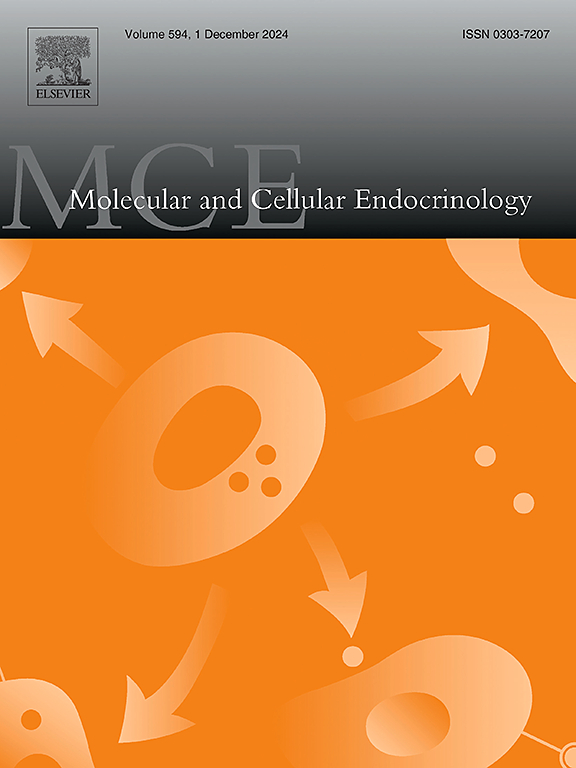Dietary advanced glycation end products (AGEs) and superovulation with gonadotropins alter RAGE expression in the ovaries differently at each follicular stage of development
IF 3.8
3区 医学
Q2 CELL BIOLOGY
引用次数: 0
Abstract
The purpose of this study was to examine the deposition of advanced glycation end products (AGEs) and their receptors, RAGE, in ovarian follicles during folliculogenesis in mice fed high (H-AGE) or low (L-AGE) AGE diets and following superovulation with gonadotropins. We hypothesize that H-AGE diet is associated with increased AGE deposition and RAGE expression in various stages of ovarian follicular development, and superovulation with gonadotropins may alter these changes. C57BL/6J mice were fed low L-AGE (n = 10) or H-AGE (n = 10) diet for 12 weeks. In each group, half of each cohort (n = 5) were sacrificed at the end of 12 weeks while the other half (n = 5) were superovulated prior to sacrifice. Immunofluorescence staining of ovarian sections was used to determine AGE deposition and RAGE expression in ovarian follicles in a semi-quantitative manner. In all mice, AGE deposition and RAGE expression were observed in granulosa but not theca cells. In all mice, AGE deposition intensity increased as the follicles progressed through developmental stages from primordial to primary to secondary to prenatral/antral but then significantly dropped in the corpus luteum stage. RAGE staining was highly expressed equally in all stages of pre-ovulatory follicles but then significantly dropped in the corpus luteum post-ovulatory stage. Compared to mice on L-AGE diet, mice on H-AGE mice had significantly lower AGE deposition in their primordial follicles and lower RAGE intensity in their antral follicles. Following superovulation, mice in both groups had significantly lower AGE deposition and significantly lower RAGE expression but the drop in AGE deposition following superovulation was more pronounced in the H-AGE diet group compared to the L-AGE diet group in both pre-ovulatory and post-ovulatory follicles. Ovarian AGE deposition and RAGE expression changes differently during the natural follicular development. Opposite to expectations, the intake of diet rich in AGEs caused lower expression of the proinflammatroy RAGE, an effect that was more pronounced after gonadotropin exposure.
膳食中的高级糖化终产物和促性腺激素超排卵会改变卵泡发育各阶段卵巢中的 RAGE 表达。
本研究的目的是检测喂食高(H-AGE)或低(L-AGE)AGE饮食并使用促性腺激素超排卵的小鼠在卵泡生成过程中高级糖化终产物(AGE)及其受体 RAGE 在卵泡中的沉积情况。我们推测,H-AGE饮食与卵泡发育各阶段AGE沉积和RAGE表达的增加有关,而促性腺激素超排卵可能会改变这些变化。用低L-AGE(10只)或H-AGE(10只)饮食喂养C57BL/6J小鼠12周。每组中有一半(n=5)在12周结束时被处死,另一半(n=5)在处死前接受超排卵。对卵巢切片进行免疫荧光染色,以半定量的方式确定卵巢滤泡中的 AGE 沉积和 RAGE 表达。在所有小鼠的颗粒细胞中都观察到了 AGE 沉积和 RAGE 表达,而在卵巢细胞中没有观察到。在所有小鼠中,AGE沉积强度随着卵泡发育阶段(从原始卵泡到初级卵泡到次级卵泡到产前/产后卵泡)的进展而增加,但在黄体阶段显著下降。RAGE染色在排卵前卵泡的所有阶段都同样高度表达,但在排卵后黄体阶段则显著下降。与食用L-AGE饲料的小鼠相比,食用H-AGE饲料的小鼠原始卵泡中的AGE沉积明显较低,前卵泡中的RAGE强度也较低。超排卵后,两组小鼠的 AGE 沉积和 RAGE 表达均明显降低,但与 L-AGE 饮食组相比,H-AGE 饮食组小鼠超排卵后在排卵前和排卵后卵泡中的 AGE 沉积下降更为明显。在自然卵泡发育过程中,卵巢 AGE 沉积和 RAGE 表达发生了不同的变化。与预期相反,摄入富含 AGEs 的饮食会降低促炎症 RAGE 的表达,这种效应在促性腺激素暴露后更为明显。
本文章由计算机程序翻译,如有差异,请以英文原文为准。
求助全文
约1分钟内获得全文
求助全文
来源期刊

Molecular and Cellular Endocrinology
医学-内分泌学与代谢
CiteScore
9.00
自引率
2.40%
发文量
174
审稿时长
42 days
期刊介绍:
Molecular and Cellular Endocrinology was established in 1974 to meet the demand for integrated publication on all aspects related to the genetic and biochemical effects, synthesis and secretions of extracellular signals (hormones, neurotransmitters, etc.) and to the understanding of cellular regulatory mechanisms involved in hormonal control.
 求助内容:
求助内容: 应助结果提醒方式:
应助结果提醒方式:


